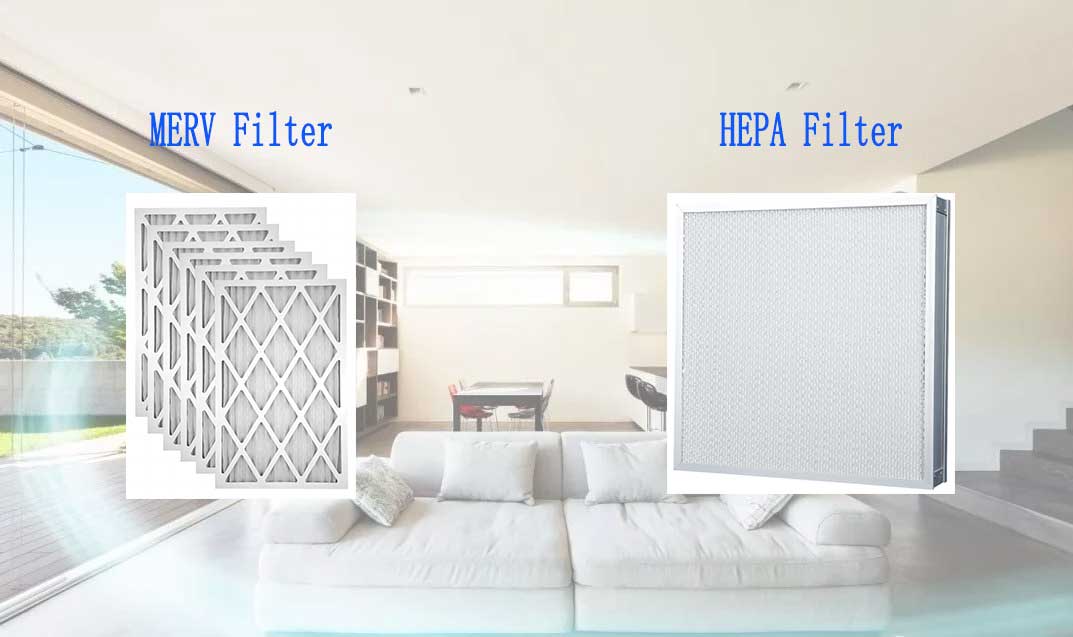 March 27, 2024
March 27, 2024
What is a MERV filter?
A MERV filter, standing for Minimum Efficiency Reporting Value, is a rating system designed to classify the efficiency of air filters in terms of their ability to capture particles of varying sizes. The MERV rating system ranges from 1 to 20, with higher numbers indicating a filter's superior ability to trap smaller particles. This system helps consumers and professionals choose air filters based on the quality of air filtration they need.
MERV 1-4: These filters provide minimal filtration and are typically used in residential settings to protect HVAC equipment from larger particles like pollen, dust mites, and carpet fibers.
MERV 5-8: Suitable for residential and commercial settings, these filters can capture mold spores, dust mite debris, and pet dander.
MERV 9-12: These filters are better suited for commercial buildings and homes with high-quality air needs, capturing particles as small as auto emissions and legionella.
MERV 13-16: Often used in hospital and general surgery settings, these filters can trap bacteria, tobacco smoke, and sneeze droplets.
MERV 17-20: These are HEPA or high-efficiency filters used in cleanrooms and places where air purity is critical. They capture particles as small as viruses and combustion smoke.
When choosing a MERV-rated filter, it's essential to consider both the level of air quality desired and the capability of the HVAC system to handle the filter's airflow resistance. Higher MERV ratings mean finer filtration but also more resistance to airflow, which can strain HVAC systems not designed to accommodate such filters.
What is a HEPA filter?
A HEPA filter, which stands for High Efficiency Particulate Air filter, is a type of air filter that meets specific standards of efficiency set by the U.S. Department of Energy (DOE). To qualify as HEPA by U.S. government standards, an air filter must remove at least 99.97% of particles that are 0.3 microns (µm) in diameter from the air that passes through it. The 0.3 µm size is considered the most penetrating particle size (MPPS), meaning it is the hardest size for a filter to capture. HEPA filters are designed to target much smaller pollutants and particles, including pollen, pet dander, dust mites, tobacco smoke, and bacteria.
HEPA filters are composed of a mat of randomly arranged fibers, typically made from fiberglass. The fibers' diameters and the filter's thickness vary. The filter captures particles through a combination of the following mechanisms:
Interception: Particles following a line of flow in the air stream come within one radius of a fiber and adhere to it.
Impaction: Larger particles are unable to avoid fibers by following the curving contours of the air stream and are forced to embed in one of them directly; this increases with diminishing fiber separation and higher air flow velocity.
Diffusion: Smaller particles, especially those smaller than 0.1 µm, collide with gas molecules and are thereby impeded and delayed in their path through the filter; this behavior is similar to Brownian motion and raises the probability that a particle will be stopped by either of the two mechanisms above; it becomes dominant at lower air flow velocities.
Electrostatic Attraction: Some HEPA filters are electrostatically charged to attract particles, increasing the efficiency of capture.
HEPA filters are used in a variety of applications where clean air is required, such as in medical facilities, aircraft, homes, and industries that deal with radioactive materials or pathogens. While HEPA filters can significantly improve indoor air quality, they do require regular replacement to maintain efficiency, and their performance can be affected by the volume of air passing through the filter and the amount of pollutants in the environment.

The primary differences between MERV filters and HEPA filters lie in their filtration efficiency, the size of the particles they are designed to capture, and their typical applications. Here’s a breakdown of the key differences:
1. Filtration Efficiency:
MERV Filters: The Minimum Efficiency Reporting Value (MERV) system rates filters on a scale from 1 to 20 based on their ability to capture particles of varying sizes (from 0.3 to 10 microns). Higher MERV ratings indicate higher filtration efficiency, with MERV 13 and above being capable of capturing particles as small as 0.3 microns with a good efficiency, but typically less than that of HEPA filters.
HEPA Filters: High Efficiency Particulate Air (HEPA) filters must meet a standard of removing at least 99.97% of particles that are 0.3 microns in diameter from the air that passes through them. This makes HEPA filters significantly more efficient at capturing very fine particles compared to most MERV-rated filters.
2. Particle Size:
MERV Filters: These filters are designed to capture a wide range of particle sizes, effectively filtering larger particles like pollen, dust mites, and fibers, as well as smaller particles including bacteria and droplet nuclei, depending on the MERV rating.
HEPA Filters: HEPA filters specialize in capturing very small particles, including bacteria, viruses, and fine dust particulates. Their design is optimized for trapping particles down to 0.3 microns with extremely high efficiency.
3. Applications:
MERV Filters: These are widely used in residential, commercial, and industrial HVAC systems to improve air quality and protect equipment. The specific MERV rating chosen often depends on the desired balance between filtration efficiency and air flow restriction, with higher MERV filters used in settings requiring cleaner air.
HEPA Filters: Due to their high filtration efficiency, HEPA filters are used in settings where air purity is critical, such as in hospitals, clean rooms, and laboratories. They are also found in certain residential and commercial air purifiers, vacuum cleaners, and airplanes.
4. Air Flow and System Compatibility:
MERV Filters: Lower to mid-range MERV filters are generally designed to work with standard HVAC systems without significantly impeding air flow. However, higher MERV filters may require systems designed to handle the increased air resistance.
HEPA Filters: The dense structure of HEPA filters means they create more resistance to airflow, which can strain HVAC systems not specifically designed to accommodate them. They are often used in stand-alone air purification units or in HVAC systems designed or adapted to handle the higher resistance.
In summary, while both MERV and HEPA filters aim to improve air quality, HEPA filters offer superior efficiency at capturing finer particles, making them suitable for more critical applications, whereas MERV filters provide a range of options suitable for everyday use in residential, commercial, and some industrial settings. Choosing between them involves considering the specific needs for air purification, the size of particles of concern, and the capabilities of the existing HVAC or air purification system.

